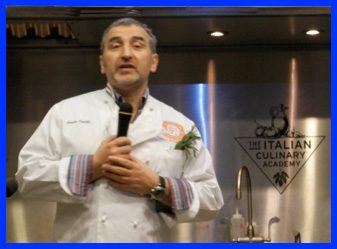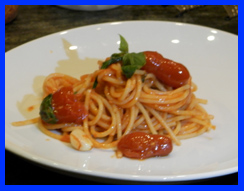 Spaghetti al Pomodoro, a glorious celebration of tomatoes, olive oil, basil, spaghetti, and Grana Padano cheese at the International Culinary Center in New York City to celebrate the Feast of Saint Anthony the Abbot. Presented by Chef Cesare Casella, Dean of the Italian Studies of the International Culinary Center, it was a day of learning and tastings.
Spaghetti al Pomodoro, a glorious celebration of tomatoes, olive oil, basil, spaghetti, and Grana Padano cheese at the International Culinary Center in New York City to celebrate the Feast of Saint Anthony the Abbot. Presented by Chef Cesare Casella, Dean of the Italian Studies of the International Culinary Center, it was a day of learning and tastings.
Saint Anthony the Abbot is celebrated throughout Italy and the world on January 17th, which also is the beginning of Italian carnival and is a time where food and drink are celebrated and as the saying goes, "transgressions are allowed," so, let the party begin.
Chef Cesare Casella
Spaghetti al Pomodoro (Spaghetti with tomato sauce) was demonstrated by three under 35 years-old chefs using the same ingredients and prepared three different ways resulting in three very tasty dishes. Chef Matteo Bergamini of SD26 Restaurant in New York City, Chef Enrico Bartolini of the two-star Michelon Devero Ristorante in Milano, Italy, and Chef Luca Signoretti of Roberto’s Restaurant in Dubai, UAE each demonstrated their method for sautéing garlic, folding in the tomatoes, finishing the pasta, garnishing with fresh herbs, and readying the dish for a toping of Grana Padano cheese.
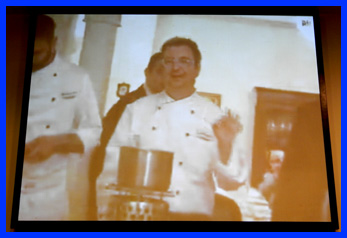
Celebrating Spaghetti al Pomodoro
Live from Ristorante President Pompei – Naples, Italy
In addition to the demonstrations and tastings, the day included discussions on selecting olive oil, which Grana Padano cheese to use in different situations, a brief history of the tomato, live video conference discussions with the Ristorante President in Pompei – Naples, Italy and Villa Torretta Hotel in Milan, Italy who were celebrating Spaghetti al Pomodoro, and concluded with the presentation of "Italian Cuisine in the USA Awards" by Grana Padano; it was a day for all the senses.
The Ingredients
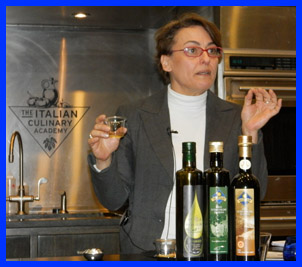
Ms. Lidia Rinaldi of Consorzio Nazionale Degli Olivicoltori
Olive Oil – Ms. Lidia Rinaldi, a consultant for Consorzio Nazionale Degli Olivicoltori (The Italian National Consortium of Olive Growers) noted that with over 700 varietals of olive trees there was a need to control the quality and distribution of olive oil. With over 40 years, 200,000 olive producers, 100,000 tons of virgin olive oil produced per year by just their consortium, that the adherence to quality controls and standards has never been more important. She also noted that in the near future each bottle produced by their consortium will contain a barcode that once scanned would reveal the specific region, type of olive tree, and producer, much like a bottle of wine. After an informative and educational tasting of three very different but excellent olive oils, which allowed for Ms. Rinaldi to demonstrate the unique subtleties that exist across different types of olives and regions, we were ready to learn about Grana Padano.
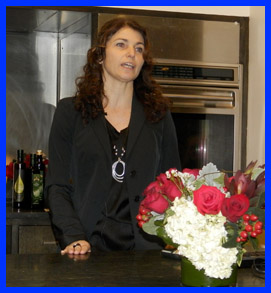
Ms. Elisabetta Serraiotto of Consorzio Grana Padano
Grana Padano – Ms. Elisabetta Serraiotto representing the Consorzio Grana Padano discussed the different methods used to craft a cheese of the quality of Grana Padano. In addition she discussed the use for different aged cheese, for example, 9 – 16 months is softer and is great for melting on dishes, 16 – 20 month aged cheese has a nuttier taste and is great for grating on dishes such as spaghetti al pomodoro, and greater than 20 months aged cheese is an excellent complement with red wine.
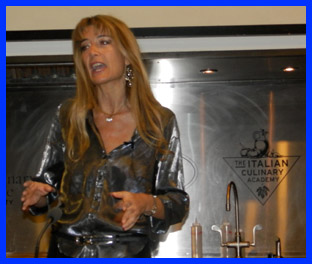
Ms. Alessandra Rotondi – The Story of the Tomato
The Tomato – Ms. Alessandra Rotondi’s discussion took the attendees through a brief history of the fruit known as the tomato from its origins in Ecuador and Peru to the Spanish brining it to Europe in the 15th century. She explained how this exceptional product did not always hold a positive position in the culinary world. Being an acidic fruit, it initially was thought to be poisonous when it was served on pewter dishes where the acid drew out the lead from the dishes resulting in a misleading assault and designation as a poisonous fruit. However, through the fortunate meeting of Thomas Jefferson and the tomato during a trip to Europe in the early 1700’s, he revived the fortunes of the tomato. In addition to Thomas Jefferson, Mr. Joseph Campbell of Campbell Soup fame brought the product to the shelves and homes across the USA in the late 1800’s.
An interesting fact closed out Ms. Rotondi’s discussion of the tomato that the marriage of the tomato and spaghetti was not noted in recipe books until 1790 almost 100 years after it was mentioned as an ingredient with eggplant and zucchini; the tomato has come a long way.
The Tasting
Each chef used the same ingredients, but it was interesting to watch how they constructed their dishes. There were no formal recipes provided, but being in the second row provided an inside view as to how they prepared their dishes.
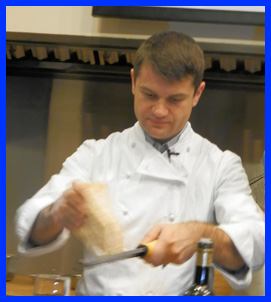
Chef Enrico Bartolini
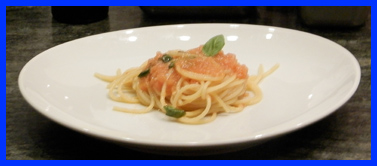
Chef Enrico Bartolini’s Spaghetti al Pomodoro
Chef Enrico Bartolini of Devero Restaurante, Milano, Italy, a Two Michelin Star restaurant, started by crushing his garlic and sautéing it in olive oil in a large sauté pan. He took partially cooked pasta and added it directly to the olive oil and garlic and then added some of the pasta water to create enough liquid to finish cooking the pasta. After a few minutes Chef Bartolini added sliced fresh Italian tomatoes to his dish and using a wooden spoon he mixed the ingredients in the pan. With a twist of his tongs he plated his spaghetti al pomodoro and garnished it with fresh basil leaves.
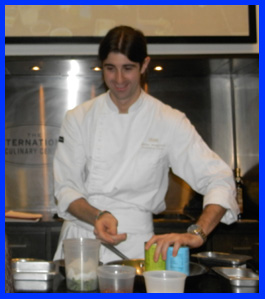
Chef Matteo Bergamini
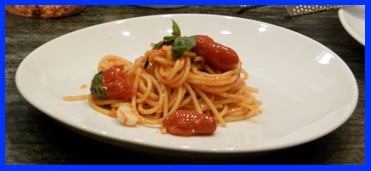
Chef Matteo Bergamini’s Spaghetti al Pomodoro
Chef Matteo Bergamini of SD26 Restaurant in New York City started by smashing garlic cloves with his palm and adding them to a large sauté pan with olive oil. Chef Bergamini then opened a can of imported Italian tomatoes and sliced them and added them to the sautéed garlic and using a wooden spoon mixed the tomatoes with the olive oil. Chef then added partially cooked pasta to the mixture of olive oil, sautéed garlic, and tomatoes along with some pasta water to create enough liquid to finish cooking the pasta. As the pasta finished cooking in the sauté pan, he added some more tomatoes. He plated his spaghetti al pomodoro and garnished it with additional sliced tomatoes and fresh basil leaves.

Chef Luca Signoretti
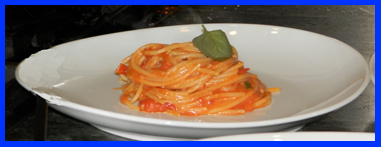
Chef Luca Signoretti’s Spaghetti al Pomodoro
Lastly, Chef Luca Signoretti of Roberto’s Restaurant in Dubai, UAE used whole garlic cloves and cooked them in olive oil. After the garlic had cooked for a few minutes he added some canned tomatoes to the mixture and using a large slotted spoon he mashed the tomatoes in the garlic and oil mixture. He added some pasta water and cooked down the mixture, added some more tomatoes and water and then cooked down the mixture. He added water three or four times to the mixture and each time cooked the mixture down creating a sauce. He took partially cooked pasta and finished cooking it in the large sauté pan mixture and added pasta water as needed to create enough liquid to finish cooking the pasta. He plated his spaghetti al pomodoro and garnished it with fresh basil leaves.
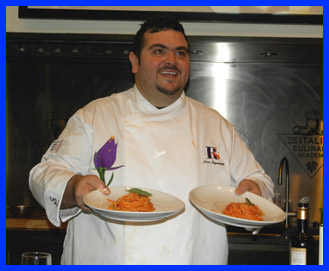
Mangia Bene
Each attendee received a nice glass of prosecco and a sampling of each of the Chef’s dishes and the room fell silent for the first time all day.
The Awards
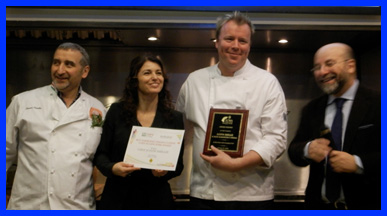
Chef Justin Smilie
"Best Emerging Chef of Italian Cuisine in the USA"
The day finished with the presentation of the "Italian Cuisine in the USA Awards" by Grana Padano. Recipients were: Lou di Palo, specialty food merchant, for "Lifetime Commitment to the Promotion of Italian Cuisine, its Ingredients, and the Food and Wine of Italy," and Chefs, Francesco Farris of Zio Cecio, Dallas, Texas and Walter Potenza of Potenza Ristorante-Bar, Cranston, Rhode Island each received an award for "Lifelong Commitment to the Promotion of Quality, Authentic Italian Cuisine in the USA" The "Best Emerging Chef of Italian Cuisine in the USA" went to Justin Smillie of Il Buco Alimentari & Vineria of New York City.
The International Day of Italian Cuisine

Rosario Scarpato
The International Day of Italian Cuisine was started by food critic Rosario Scarpato to celebrate Italian Cuisine and as he stated, "New York is the ideal capital of Italian cuisine abroad." The event, which began in 2008, celebrates its 7th year promoting authentic Italian cuisine and in the past has featured dishes such as tiramisu and osso buco. Scarpato commented that with the explosion of the "foodie," going forward they will feature lesser-known dishes to heighten interest and knowledge of various regions, ingredients, and foods throughout Italy.
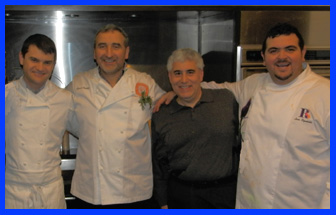
Chefs Enrico Bartolini, Cesare Casella,
Luca Signoretti and Edward Nesta
Follow Luxury Experience on Facebook and see more photos from the event. www.Facebook.com/LuxuryExperience
Follow The International Culinary Center on Facebook www.Facebook.com/InternationalCulinaryCenter
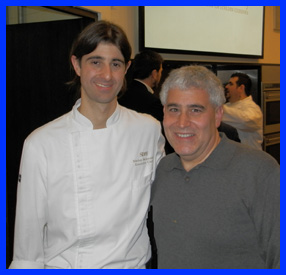
Chef Matteo Bergamini and Edward Nesta
For information on taking classes throughout the year with the excellent chef instructors at The International Culinary Center at their New York, California, or Italian Campuses, please visit the website: www.InternationalCulinaryCenter.com.
The International Culinary Center, founded as The French Culinary Institute
462 Broadway
New York, New York 10013
United States
Toll-Free Telephone: +1-888-324-2433
Email: info@internationalculinarycenter.com
Website: www.InternationalCulinaryCenter.com
The International Culinary Center of California
700 West Hamilton Avenue
Campbell, California 95008
United States
Toll-Free Telephone: +1-866-318-2433
Email: info@internationalculinarycenter.com
Website: www.InternationalCulinaryCenter.com
© January 2014. Luxury Experience. www.LuxuryExperience.com. All rights reserved.

